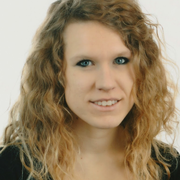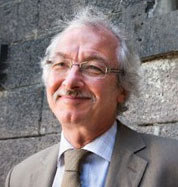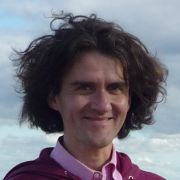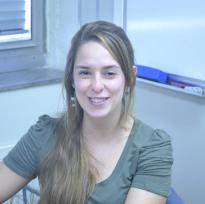
Wednesday 8 March 2017
The effects of memory load in attention: a review of studies, implications in the study of attention and new challenges
Beatriz Gil-Gómez de Liaño

Time: 11.00-13.00
Venue: Musatti room Department of Psychology, via Venezia 8
Speaker:Beatriz Gil-Gómez de Liaño
Affiliation:Universidad Autónoma de Madrid, Spain
Organization: Franca Stablum
Abstract
The effects of concurrent working memory load in attentional processes have been one of the most puzzlingissues in cognitive psychology. Studies have shown detrimental effects, no effects, and even beneficial effects of working memory load in different attentional tasks. In this presentation I will review several important studies about the effects of working memory in attention using different attentional paradigms, from the Flanker and Stroop-like task to Visual Search paradigms. I will also show preliminary results from an ongoing meta-analytical review we are working on, providing several explanations and variables that may account for part of the results found. In fact, results from other recent studies support part of those found by the ongoing meta-analysis. However, one of the conclusions of the first results of the meta-analytical study points to an important problem highly emphasized nowadays in science: the possibility of a publication bias in the field. That will lead me to show you an example of a failure to replicate an important study in the field of memory effects in Stroop-like tasks, made in collaboration with Dr. Stablum and Dr. Umiltà.I will conclude about the necessity to use replicability as an essential tool for research development, and specifically in the field here shown
______________________________________________________________________
Thursday 12 January 2017
The design of complex sociotechnical systems.
Automatic text simplification: confluence of challenges for Psychology and Computer Science
Inmaculada Fajardo

Time: 14.30-16.00
Venue: Room DPSS 2 (main entrance of the Department of Developmental Psychology, via Venezia 8, first room on the left)
Speaker: Inmaculada Fajardo
Affiliation: ERI-Lectura, University of Valencia, Spain
Organization: Barbara Arfè
Abstract
International standards organization like the World Wide Web Consortium (W3C) have manifested interest in bringing closer digital texts to people with reading difficulties since they constitute a core source of information for citizenship. A way to do it is "automatic text simplification" which can be addressed from different points of
view, not always converging, such as computational linguistics, psycholinguistics, sociology or design. The goal of this seminar is twofold: 1) To analyze, from the point of view of the psycholinguistics and developmental psychology, the nature of reading comprehension difficulties in several disabilities and developmental disorders (e.g. Autism Spectrum Disorder and Intellectual Disability) based on behavioral and eye tracking measures (Fajardo et al., 2013, 2014) and 2) To identify, from the point of view of computer science, existing solutions and challenges of automatic assessment of text complexity and text simplification (TAACO [Crossley et al., 2016]; FIRST [González-Navarro y col., 2014], TERENCE [Arfé, Oakhill & Pianta, 2014]).
Recommended readings
Fajardo, I., Tavares, G., Ávila, V., & Ferrer, A. (2013). Towards text simplification for poor readers with intellectual disability: When do connectives enhance text cohesion?. Research in developmental disabilities, 34(4), 1267-1279.
Crossley, S. A., Kyle, K., & McNamara, D. S. (2015). The tool for the automatic analysis of text cohesion (TAACO): Automatic assessment of local, global, and text cohesion. Behavior research methods, 1-11.
______________________________________________________________________
December 8 2016
Learning and reasoning with knowledge data: A review of my favourite approaches.
Automatic text simplification: confluence of challenges for Psychology and Computer Science
Luciano Serafini
Time: 15:30
Venue: 1BC45, Torre Archimede
Speaker: Luciano Serafini
Affiliation: Fondazione Bruno Kessler, Trento, Italy
Organization: Alessandro Sperduti
Abstract:
Hybrid domains are domains where objects are organised in a structure (e.g., a labelled graph) and some of the components of such a structure is associated to a set of numerical attributes or features (e.g., the vertex of a graph are associated with numeric features, and the arcs are associated to weights). In these domains, structural properties and numerical properties are tightly connected and they cannot be managed separately. On the one hand, logical approaches provide excellent tools to describe some known structural properties of a domain and to automatically infer via deductive reasoning new true properties about the structures that logically follows from them. On the other hand, machine learning techniques, such as regression, kernels, support vector machines, neural networks and graphical models, are quite useful and flexible methodologies to infer, via inductive reasoning (aka learning), new numerical and structural properties from the numerical attributes/featur!
es associated to the domain. Since it's beginning Artificial Intelligence dream has been to find a satisfactory integration of these two forms of inference. Along the years many proposals have been done, but they never get to the state of being mature enough. It's only in the recent years, that researchers were looking to suitably combine Logical reasoning and machine learning in hybrid domains, and they developed a number of frameworks which seem to be promising for the solution of such a key AI challenge. In this talk I'll revise some of them. In particular, I'll give an overview of the main principles, which is at the base of all the modern approaches, and I'll briefly present some of the emerging approaches.
______________________________________________________________________
08 JUNE 2016
A Mathematical Model to Predict Glioblastoma Invasion: use of patient-specific diffusion tensor imaging data in simulations
Maria Cristina Colombo
 Time: 08 JUNE 2016 - 18:00
Time: 08 JUNE 2016 - 18:00
Venue: MEETING ROOM at HIT Centre, via Luzzati 4
Speaker: Maria Cristina Colombo
Affiliation: TRILOG Spa, Milan
Abstract:
Even though brain tumors account for only 2-3% of all cancers, they are responsible for 7% of the years of life lost from cancer before the age of 70. Among them, the most aggressive is the glioblastoma, a highly malignant cancer that arises in the neuroglia, the supportive tissue of the neurons. Glioblastoma presents long extensions that infiltrate deeply the white matter, following the alignment of the fibers. From the medical viewpoint, this peculiarity makes it difficult to treat. For the same reasons, in the last years, biomathematical modeling applied to infiltrative brain tumor has gained in importance. Indeed, a good model could offer a better understanding of the microstrucutral dynamics of the cancer and thus it could be helpful to predict its evolution. In this study, we propose a diffuse interface binary mixture model which consists of a fourth order non-linear equation for the cancerous cellular fraction coupled with a reaction diffusion equation for the nutrient component. The model takes into account the mechanical dynamics, e.g. adhesive forces or viscous interactions among cells, and the chemotactic cellular movement in response to certain environment factors. Moreover, we include brain tissue heterogeneity and anisotropy in the model by the introduction of patient-specific diffusion tensor imaging data, thanks to which we manage to probe brain fibers architecture. The aim of this research is to demonstrate the importance of considering anisotropy, heterogeneity and patient-specific data into mathematical models in order to better predict the tumor growth. Specifically, we deal with the theoretical and the numerical framework of the mathematical model proposed. Starting from a real MR of a patient affected by glioblastoma and using imaging techniques, we create a patient-specific computational mesh and we extract the necessary data from the DTI medical images. Then we develop numerical codes making use of an open-source software name FEniCS. To study the anisotropic development of the tumor in relation to the biological parameters presented in the model, we per-form a sensitivity analysis on a homogeneous geometry. Finally, we provide two numerical tests that simulate common clinical situations.
______________________________________________________________________
June 17th, 2015
The design of complex sociotechnical systems.
A discussion of the role of human-centered design is complex systems, such as healthcare and automation in the home, workplace, and the automobile
Donald Norman
 Time: June 17th 2015, 14.30
Time: June 17th 2015, 14.30
Venue: Sala dei Giganti, corte Arco Valaresso 7 (contiguous to piazza
Capitaniato)
Speaker: Donald Norman (cv)
Affiliation: co-director of the Design Lab at the UCSD, and co-founder
of Nielsen-Norman Group
Program of the event
Greetings from University authorities
Francesco Gnesotto, Vicerector of the University of Padua
Introduction
Anna Spagnolli, HIT Research Centre - Department of General Psychology UNIPD
Lectio Magistralis
Don Norman
Interactive session and selected questions from the audience
Sebastiano Bagnara (UNISS), Luciano Gamberini (UNIPD), Oronzo Parlangeli (UNISI), Steve Poltrock (Boeing), (more to be confirmed),
Bio
My formal education is in Electrical Engineering and Psychology. I've served as a faculty member at Harvard, University of California, San Diego, Northwestern, and KAIST (South Korea). I've also worked in industry as a VP at Apple and an executive at HP and a startup). Today my emphasis is on helping technology companies structure their product lines and business. My major emphasis is design strategy: how designers and design thinking can help drive both incremental and radical innovation within the company. I've retired twice, once from the University of California, San Diego (where I was founder and chair of the department of Cognitive Science) and once from Northwestern University, where i was a professor of Computer Science and Design, co-directing the MMM dual degree program between the School of Engineering and the Kellogg School of Management, a program that gave students both an MBA and engineering degree, with the focus on design and operation. I am co-founder and principal of the User Experience/Usability consulting firm, the Nielsen Norman group, which is the home for my consulting and keynote talks. I'm an IDEO fellow and a member of the Board of Trustees of IIT's Institute of Design in Chicago. My latest books are "Living with Complexity" and "The Design of Everyday Things: Revised and Expanded."
More infot at www.jnd.org
______________________________________________________________________
May 26th, 2015
Repertory grid technique: a versatile, computer-analysed method of assessing the structure and content of a person’s view of the world
David Winter
 Time: May 26th 2015, 14.30
Time: May 26th 2015, 14.30
Venue: Dept. of General Psychology, Via Venezia 8, Padova (Aula Musatti)
Speaker: David Winter
Affiliation: Director of the Doctorate in Clinical Psychology at the University of Hertfordshire, U.K
Abstract:
Repertory grid technique is the principal assessment method derived from George Kelly’s personal construct theory. It has been used in over 90% of personal construct research investigations, both quantitative and qualitative, as well as in practical applications of the theory in a wide range of settings, including clinical practice, education, and organisational consultancy. This talk will outline the technique and methods of grid analysis, including the demonstration of a software package from which can be derived indices of the structure of the person’s view of the world, others that focus on its content, and measures of psychological conflict. There will be consideration of how the grid can be used not only with individuals but to explore the construct systems of couples and groups; and of how it can be administered by computer, with instant feedback of results and the possibility of a ‘therapeutic’ interaction between the computer and the subject. More recent variations on Kelly’s original procedure will be described, as will other personal construct assessment methods. Examples will be provided of the use of repertory grid technique and related methods in clinical practice and in a variety of research studies, ranging from my work in the English National Health Service and on serial killing to studies conducted with former child soldiers and other survivors of a brutal civil war in Africa. The talk will therefore demonstrate the adaptability of repertory grid technique to work with people across the age spectrum in numerous different contexts.
David Winter is Professor of Clinical Psychology and Programme Director of the Doctorate in Clinical Psychology at the University of Hertfordshire, U.K., and is currently a Visiting Professor in the Department of General Psychology at the University of Padova. His previous working life was spent practising as a clinical psychologist and personal construct psychotherapist in the English National Health Service. He is a Fellow of the British Psychological Society and former Chair of its Psychotherapy Section and of the Research Committee of the UK Council for Psychotherapy; and is Associate Editor of the Journal of Constructivist Psychology and research Editor of the European Journal of Psychotherapy and Counselling. He has published extensively in the areas of personal construct psychology and psychotherapy research, and his books include Personal Construct Psychology in Clinical Practice: Theory, research and applications, Personal Construct Psychotherapy: Advances in theory, practice and research (edited with Linda Viney), The Wiley-Blackwell Handbook of Personal Construct Psychology (forthcoming: edited with Nick Reed), and Trauma, Survival and Resilience in War Zones: The psychological impact of war in Sierra Leone and beyond (forthcoming: with Rachel Brown, Stephanie Goins, and Clare Mason).
______________________________________________________________________
March 5th, 2015
Understanding Symbiotic Interaction
David Kirsh Time: 5 March 2015, 11.00 am
Time: 5 March 2015, 11.00 am
Venue: Aula Metelli (Dept. of General Psychology, via Venezia, 8)
Speaker: David Kirsh
Affiliation: Dept of Cognitive Science, UCSD, La Jolla, CA
Abstract:
A symbiot is a software agent, hardware element or virtual agent that a) acts or lurks in a given environment inhabited by one or more humans, b) delivers value to those humans, and c) benefits from providing that ‘help’. In nature famous examples of mutualistic symbiosis are bees pollinating flowering trees and plants: the bees get protein and fats from pollen and carbohydrates from nectar while the trees and plants are fertilized which is necessary for producing fruits and reproducing. Humans who collect bees and release them in underserviced areas could be part of this mutually beneficial chain if they are rewarded, as would any device that improves the effectiveness of pollination since bees miss so many flowers. With the emergence of apps distributed in millions of cell phones, and the growing use of crowd sensing, crowd sourcing, pocket drones and human augmentation, the social and cognitive dynamics of our world are starting to change. There are new possibilities for coordination, collaboration and managing complexity.
In this talk I will explore the basic principles of symbiotics using examples from evolution, contextual robotics, and devices that support disintermediation and distributed and augmented cognition.
Bio Blurb:
David Kirsh is Professor and past chair of the Department of Cognitive Science at UCSD. He was educated at Oxford University (D.Phil), did post doctoral research at MIT in the Artificial Intelligence Lab, and has held research or visiting professor positions at MIT and Stanford University. He has written extensively on situated cognition and especially on how the environment can be shaped to simplify and extend cognition, including how we intelligently use space, and how we use external representations as an interactive tool for thought. He runs the Interactive Cognition Lab at UCSD where the focus is on the way humans are closely coupled to the outside world, and how human environments have been adapted to enable us to cope with the complexity of everyday life. Some recent projects focus on ways humans use their bodies as things to think with, specifically in dance making and choreographic cognition. He is co-Director of the Arthur C. Clarke Center for Human Imagination, and he is on the board of directors for the Academy of Neuroscience for Architecture.
______________________________________________________________________
February 18th, 2015
Brain-Computer Interface technology beyond medical applications
Benjamin Blankertz
 Time: February 18th, 2015, 14.30
Time: February 18th, 2015, 14.30
Venue: Dept. of General Psychology, Via Venezia 8, Padova (Aula Magna)
Speaker: Benjamin Blankertz
Affiliation: TU Berlin - Technische Universität Berlin
Abstract:
Brain-Computer Interfacing (BCI) is a well established technology, however its application in the real world is practically absent. While the original motivation to develop BCIs and also most of current research is focused on clinical usage, a growing literature provides the foundations for novel non-medical applications. These approaches include (a) the usage of BCI as a research tool, e.g., closed loop experiments to investigate cognitive processes and psychophysical phenomena; (b) enhancement of human-computer interaction, e.g., by estimating covert user states from brain signals and employing this information for a better interpretation of the user's intent; (c) improving machines and communication tools by brain-based quality evaluation. In particular, application area (b) and partly (c) require the transfer of current technology, which is developed for restricted laboratory conditions that isolate the specific neurocognitive processes under investigation, towards realistic settings. This endeavor involves free viewing, mobility and natural stimuli. This talk will give an overview of the current state of BCI technology beyond medical applications and outline a path to explore and foster this direction of research toward realistic applicability.
Short Bio:
Benjamin Blankertz is full professor at TU Berlin and holds the chair for Neurotechnology. After receiving his PhD in mathematics in 1998 and pursuing several studies in music cognition, he started in 2000 heading the Berlin Brain-Computer Interface (BBCI) project together with Klaus-Robert Müller and Gabriel Curio. He is affiliated with the Bernstein Center of Computational Neuroscience in Berlin and codirector of the Berlin Focus Neurotechnology.
His main scientific interest is the development of methods for and applications of noninvasive brain-computer interfacing, in particular the transfer of BCI technology from the lab to real world applications. This includes the design of novel experimental paradigms and corresponding data analysis methods that bridge fundamental results to more complex and realistic scenarios. On the algorithmic side, his focus is on data-driven methods endowed with techniques to deal with the diversity and uncertainty of brain activity that is encountered in natural behavior.
______________________________________________________________________
February 9th, 2015
Modulating Multisensory Integration- and Mirror-Neurons - related cognitive processing with tDCS
Olivia Morgan Lapenta
 Time: February 9th, 2015, 14.30
Time: February 9th, 2015, 14.30
Venue: Via Venezia 8, aula 1 DPG
Speaker: Olivia Morgan Lapenta (CV)
Affiliation: Mackenzie Presbyterian University in São Paulo, and visiting researcher at IIT in Genova
Transcranial direct current stimulation (tDCS) is an effective, low cost, easy to use, safe and portable non-invasive neuromodulatory tool. For this reason it has been increasingly applied in experimental neuropsychological and neurophysiological investigations. An interesting field of tDCS research focus in understanding how multimodal stimuli are integrated. In this context it has been demonstrated that tDCS is an interesting tool to investigate influences of audio, visual and motor modalities into each other as well as to define the role of several associative areas in audio-visuo-motor perception and motor planning. Finally, given to its neuromodulatory effect, by uncovering the role of the abovementioned loci, future research can explore effects of modulating these networks in populations with impairments in multisensory integration.